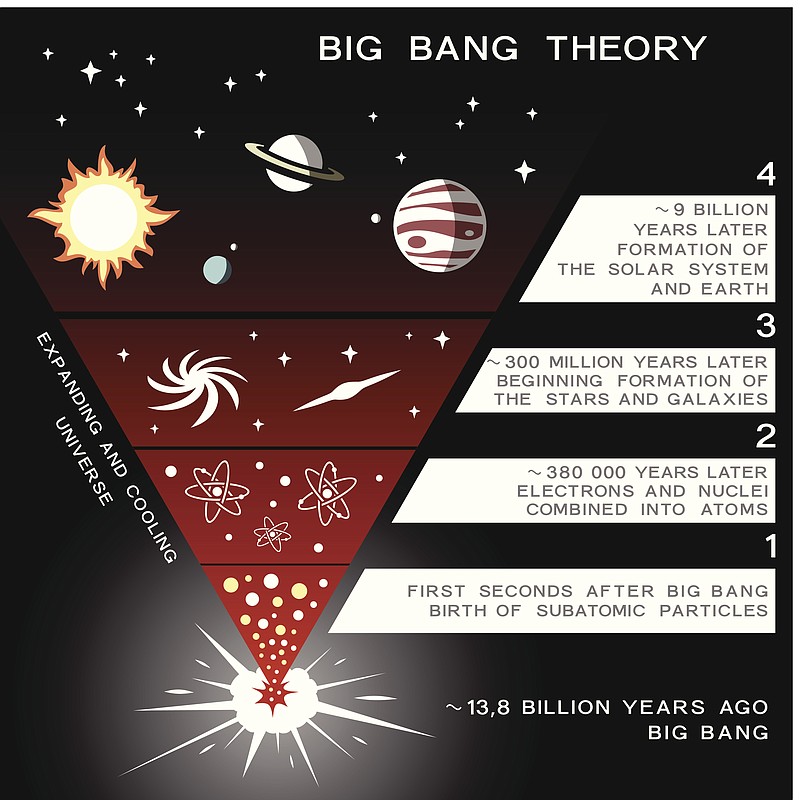Throughout history, humans have speculated about the origin of the universe. This speculation has recently progressed to scientific theories and evidence, and is a great example of the scientific process.
Astronomers hypothesized the big bang in 1929 when they discovered evidence that all the galaxies are receding from one another as if they had been driven apart by an explosion. In 1964, giant radio receivers detected the "cosmic microwave background," the big bang's faint afterglow. Today, this radiation is observed only as radio static in the microwave region of the "electromagnetic spectrum" that includes light and radio.
In 1992 and 2003, observing satellites mapped the pattern of warmer and cooler microwaves arriving from all directions. The results confirmed that the microwaves contain ripples of precisely the sort expected if the big bang did indeed develop into today's structured universe--one of the many evidences for the big bang.
But what powered the big bang? In 1979, Alan Guth concocted an idea, based on "quantum field theory" -- the physical principles governing the microscopic world -- that could answer this question.
Guth's theory was based on the broadly accepted notion that the universe is made of a handful of "quantum fields," each of them pervading the entire universe and each divided, or "quantized," into small spatially extended packages, or "quanta," of energy. The electromagnetic field is one familiar example; its quanta are called "photons."
The universe prior to the big bang comprised innumerable tiny separate bundles (quanta) of space that quickly flickered into and out of existence. There was no large-scale space or time as we know them, but only these isolated pieces of space, all subject to the quantum rules. These rules include the "uncertainty principle" according to which the energy of every quantum must fluctuate randomly. According to Guth's theory, one such random fluctuation was sufficiently large to push a new type of quantum field into action.
Once released, this "inflation field" interacted with itself in a process that increased the volume of the field exponentially -- meaning that it repeatedly doubled in size. About 60 doublings occurred, with the entire exponential process occupying a trillionth of a trillionth of a trillionth of a second. This rapidly stretched the universe, at much faster than light speed, to something the size of a grapefruit. After this huge boost, the universe continued an un-boosted expansion at light speed, a process that continues today.
This theory, called "inflation," explained many things, such as the extreme uniformity of today's universe in all directions. It explained the creation of all matter and energy as a consequence of gravity: The gravitational energy of stars and galaxies turns out to be mathematically negative, while the other forms of energy (such as motion) are positive. Thus the net energy in the universe remains essentially zero. This net energy, namely the energy of the original random fluctuation that started everything, remains only about a billion joules -- roughly the energy in a car's gasoline tank. But when this much energy is packed into a single primitive quantum, it can create a universe.
Now an experiment appears to confirm this theory. The inflationary burst should have shaken space sufficiently to create "gravitational waves" similar to electromagnetic waves but involving gravity rather than electromagnetism.
Several groups are searching for such waves. They're hard to find, because our earliest evidence is the cosmic background radiation, which wasn't created until 400,000 years after the big bang. Thus the groups look for the "signature" of gravitational waves within the background radiation. On March 17, John Kovac's microwave telescope group stationed at the South Pole announced the discovery of such a signature. Gravitational waves should create a unique swirling pattern within the "polarization directions" of the background radiation photons. Just as glare-reducing glass affects the polarization of photons passing through your car window, gravitational waves alter the polarization of the microwave background in a unique way. Kovac's group announced that the background radiation photons are in fact aligned in precisely the swirling pattern expected from the passage of an inflationary burst of gravitational waves.
The result has been hailed as "huge -- as big as it gets." But there's one big "if": The results need confirmation. Science is conservative: Game-changing new results aren't accepted unless amply confirmed by additional evidence. Since several competing groups are operating, such confirmation should not be long in coming if the results are indeed correct.
Stay tuned. The big bang continues to be the greatest story ever told, and the story isn't over yet.
ART HOBSON IS A PROFESSOR EMERITUS OF PHYSICS AT THE UNIVERSITY OF ARKANSAS.
Commentary on 04/27/2014

